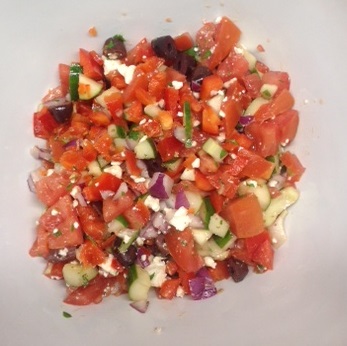Eating a Rainbow of Colors with Fruits and Vegetables
TEXARKANA, Ark. –
We’ve always been told that we eat with our eyes, meaning that if a food is attractive we may be more willing to try it versus something that doesn’t look at appetizing. Fruits and vegetables definitely add texture and color to our plates. You can enjoy a rainbow of colors, greens, reds, oranges, whites and even purples, in varieties of fruits and vegetables.
Fruits and vegetables have natural substances that give fruits and vegetables their vibrant colors, called phytochemicals. Certain phytochemicals may help protect against some cancers, heart disease, and other chronic health conditions.
Eating a variety of fruits and vegetables from each color group will help get these rich phytochemicals and other vitamins and minerals in our diet. Variety in the types of fruits and vegetables that we eat, as well as the color spectrum will yield the best health benefits.
Blues and purples promote healthy aging
Vibrant blue/purple fruits and vegetables can help maintain your urinary tract health; lower the risk of some cancers; improve memory function; and promote healthy aging. You can find them in such vegetables as purple cabbage; eggplant; purple Belgian endive; purple peppers; blackberries; blueberries; purple grapes; plums and raisins.
Green veggies lower risk of cancer
Eating green vegetables is said to provide such health benefits as a lower risk of some cancers; improved vision health; and strong bones and teeth. Consider adding these fruits and vegetables to your plate: artichokes; arugula; asparagus; broccoli; Brussels sprouts; zucchini; cucumbers; okra; peppers; avocados; green apples; kiwifruit; limes; green pears and green apples.
Improve heart health with white tan and brown fruits and veggies
White, tan and brown fruits and vegetables are also of interest to researchers and scientists due to their belief that they help to improve your heart health; maintain cholesterol levels that are already healthy; and lower the risk of some cancers.
Get all the health benefits of white by including foods such as bananas; dates; white peaches; cauliflower; mushrooms; turnips; white corn; onions; kohlrabi and garlic in your diet.
Yellows and oranges boost vitamin C
Yellow and orange colored fruits and vegetables are known to contain vitamin C, the vitamin essential in fighting off infections and colds, as well as helping keep your gums healthy. Choose from apricots; cantaloupe, grapefruit; oranges, mangoes; papayas; lemon; butternut squash; spaghetti squash; carrots; yellow peppers; pumpkin; sweet corn; and sweet potatoes.
Eat red fruits and veggies for improved heart health and memory
The last color of our rainbow is red. Red fruits and vegetables are thought to promote better health through lycopene, a relative of beta-carotene. It is thought that lycopene may help reduce the risk of some cancers, including prostrate. It is also thought to help you have a healthy heart; and help memory function and urinary tract health.
Include red fruits and vegetables in your diet through red apples; cherries; cranberries; pomegranates; strawberries; watermelon; beets; red peppers; radishes; red onions; red potatoes; rhubarb; and tomatoes.
By making sure that your diet is as colorful as a box of crayons, you will be taking advantage of all the vitamins and minerals that fruits and vegetables have to offer.
For more information on storing fruits and vegetables and making half you plate fruits and vegetables, contact the University of Arkansas Division of AG, Cooperative Extension Service, in Miller County at 870 779-3609, e-mail chadley@uada.edu. Follow me on facebook and twitter at @MillerCountyFCS for additional recipes and tips.
Greek Salad
This Greek Salad is a rainbow of colors and textures and so easy to make. It pairs perfectly with kebobs from the grill. It is best made up to 2 hours ahead for best flavor. It will make about 4 and one half cups.
- 3/4 pound tomatoes, seeded, diced (about 2 cups)
- 2 cups diced seeded peeled cucumber (about 1 large)
- 1 cup diced red bell pepper (about 1 large)
- 1/4 cup pitted kalamata olives or other black olives, halved
- 1/4 cup diced red onion
- 3 tablespoons chopped fresh Italian parsley
- 3 tablespoons extra-virgin olive oil
- 1 1/2 tablespoons red wine vinegar
- 1/2 teaspoon dried oregano
- 1/4 cup crumbled feta cheese (about 2 ounces)
Directions:
- Toss first 9 ingredients in medium bowl to blend.
- Gently mix in cheese.
- Season with salt and pepper as desired.
By Carla Haley-Hadley
County Extension Agent - FCS
The Cooperative Extension Service
U of A System Division of Agriculture
Media Contact: Carla Haley-Hadley
County Extension Agent - FCS
U of A Division of Agriculture
Cooperative Extension Service
400 Laurel Street, Suite 215 Texarkana AR 71854
(870) 779-3609
chaley@uada.edu
The Arkansas Cooperative Extension Service is an equal opportunity institution. If
you require a reasonable accommodation to participate or need materials in another
format, please contact your County Extension office (or other appropriate office)
as soon as possible. Dial 711 for Arkansas Relay.
Pursuant to 7 CFR § 15.3, the University of Arkansas System Division of Agriculture
offers all its Extension and Research programs and services (including employment)
without regard to race, color, sex, national origin, religion, age, disability, marital
or veteran status, genetic information, sexual preference, pregnancy or any other
legally protected status, and is an equal opportunity institution.
